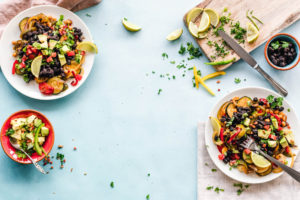by David Steele
For a lot of very good reasons, a growing number of people are concerned about genetically modified organisms (GMOs). More aptly termed ‘transgenically-modified organisms,’ these are plants and animals into which genes from very different organisms have been artificially inserted. Most of the corn and soy grown today are GMO organisms.
If we were very careful about it, we just might be able to use this technology for our true benefit. But the motives behind the vast majority of GMO crops makes being careful about it highly unlikely – unless we act soon.
There is something to say in favor of genetic engineering. As a molecular biologist, I am very sure that the development of genetic engineering has profoundly improved our understanding of how life works. Medicine has been advanced a very great deal. Even genetic engineering of food crops could conceivably be – with careful safeguards – used to benefit us with low risk. The technology might be used, for example, to overcome fungal diseases that have plagued especially third world crops for thousands of years. Success there would save so many lives. But success is unlikely.
[alert_box style=”success” close=”no”]Before a GM food can be sold in Canada, Health Canada makes sure that it is safe to eat. That said, Health Canada does not plan to do any research on GM foods at this time as they do not see them as a risk to Canadians.
The Canadian Food Inspection Agency makes sure that GM foods will not harm the environment.
GM foods do not have to be labelled in Canada or the United States. Labelling of GM foods is very difficult. This is because a GM food like corn can be used as an ingredient in many other foods like cereal, yogurt, frozen entrees and canned soup. All of these foods would need to be labelled as having genetically modified ingredients., and that would be cost prohibitive and complicated.
As a Canadian consumer, you will likely not know if the foods you buy have been genetically modified. In other parts of the world like Europe, it is mandatory to label GM foods. VOTE every chance you get for a government that cares.
[/alert_box]Attempts to accomplish this would require a great many safeguards to make sure that the crops would not do other more serious damage. Programs to maintain genetic diversity and the maintenance of already existing strains, some 10,000 years old, would be required. Unfortunately, nothing like these safeguards exist today. Nor are the goals so laudable. Instead, in our real world, GMO crops have been developed mostly to sell a specific brand of herbicide and, worse, to facilitate a takeover of the food supply by Monsanto and a few lesser competitors like Syngenta. There has been very little safety oversight.
The major crops grown in North America are now dominated by Monsanto’s Roundup-ready soy and Bt-toxin laden corn strains. Monsanto developed roundup ready soy to help sell its already popular Roundup herbicide. Farmers bought into it because, for awhile, it made weed control easy.
Most plants are killed by Roundup. If you can spray just that one chemical and get rid or your weeds, it saves a lot of labor.
The problem is that simply spraying the same chemical year in and year out on the same land is likely to evolutionarily select for weeds that are also resistant to Roundup. And, sure enough, it’s happened. Farmers are having to deal with ‘superweeds’ which grow despite the spraying. Monsanto’s solution? Partner with Dow and add resistance to a second herbicide – this one a component of the infamous Agent Orange. Bt-toxin, originally from bacteria but now expressed in Monsanto corn, similarly has (predictably) led to mass resistance in insects. They’re no longer harmed by the toxin and can feast, as before, on the corn.
In a way, these failures sound promising. The GMOs are failing. Farmers may abandon them. The problem, though, is that it is very, very hard for most farmers to do so now. Monsanto has taken over the great majority of the seed supply, and has bought up most competing seed companies.
And, because pollen carries the genes to nearby crops and because some farmers aren’t careful about the seed they sell, almost all soy and corn seed in silos today is heavily laden with Monsanto’s genes. And these things are patented. Monsanto pounces with a vengeance on anyone who would use those seeds without paying them.
Just ask Percy Schmeiser, the seed-saving Saskatchewan farmer who lost 5-4 to Monsanto in the Canadian Supreme Court for saving seed that was contaminated – probably by wind-blown cross-pollination from a neighboring farm – with Monsanto’s “Round-up Ready gene.” He didn’t contaminate it but, nevertheless, the Supreme Court has ruled, he must pay for its presence in his crop. Even unwanted cross-pollination is a profitable thing for Monsanto – what a great tool to keep farmers in line!
South of the border, just a short time ago Monsanto had a rider inserted into an essential budget bill. President Obama had little choice but to sign it – the United States government would have shut down if he didn’t. The short insert into the bill exempts Monsanto from court oversight when its experimental GMO products are planted – even if the court finds that the crop is potentially dangerous. They are trying very, very hard to consolidate their power and to buy time before their technology fails.
It is scary. But there is hope. And you can help guarantee that there is hope. People across North America are pushing for GMO labeling. Whole Foods recently announced that they will require such labeling in all they sell by 2018. Organic crops are universally GMO free. We can push back. We can prevail.
ACT: Vote with you wallet: Buy organic food. Organic food is by definition GMO-free. If you must buy conventionally-grown crops, buy those that are not genetically modified. Let your local supermarket manager know that you’re not buying the GMOs. If we all do this the supermarkets will respond. This fact sheet from Center for Food Safety will help you find the GMO free foods: http://www.centerforfoodsafety.org/fact-sheets/1974/true-food-shoppers-guide-to-avoiding-gmos.Check out the EWG’s Clean Fifteen and Dirty Dozen to make your organic purchasing more affordable and safe: http://www.ewg.org/foodnews
GROW YOUR OWN: Plant a garden. When you buy plants or seeds, ask if they have been genetically modified, but chances are they are not.
SPEAK OUT, GET HEARD: Write your MP, the Prime Minister and the Agriculture Minister. Contact Health Canada or the CFIA .Tell them that you want labeling and strict regulation. •Voice your opinion. Call food companies, and let them know you would like GM foods to be labelled. Contacts here: http://earthsave.ca/helpus
General Barcode info:
Organic produce has a five-digit number beginning with a 9. Organic bananas, for example, would be given the designation of 94011.
Conventional produce has a four-digit number beginning with a 3 or 4. Therefore, the number on conventionally grown bananas would be 4011.
Genetically engineered produce also has a five-digit number on the label and begins with an 8. Again, the number on genetically altered bananas would be 84011.
David Steele is a Research Scientist in the faculty of medicine at UBC. He holds a Ph.D. in Genetics and Molecular Biology from Emory University, in Atlanta. Dave is also the current president of Earthsave Canada.


